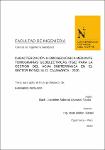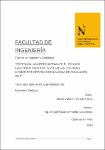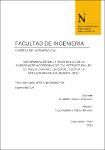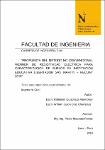Mostrar el registro sencillo del ítem
Caracterización hidrogeológica mediante tomografías geoeléctricas (TGE) para la gestión del agua subterránea en el sector Ronquillo, Cajamarca - 2020
| dc.contributor.advisor | Ocas Boñon, Rafael | |
| dc.contributor.author | Alvarado Tacilla, Jackeline Soledad | |
| dc.date.accessioned | 2020-07-02T22:52:46Z | |
| dc.date.available | 2020-07-02T22:52:46Z | |
| dc.date.issued | 2020-06-18 | |
| dc.identifier.citation | Alvarado, J. S. (2020). Caracterización hidrogeológica mediante tomografías geoeléctricas (TGE) para la gestión del agua subterránea en el sector Ronquillo, Cajamarca - 2020 (Tesis de licenciatura). Repositorio de la Universidad Privada del Norte. Recuperado de http://hdl.handle.net/11537/23902 | es_PE |
| dc.identifier.other | 551.48 ALVA 2020 | es_PE |
| dc.identifier.uri | https://hdl.handle.net/11537/23902 | |
| dc.description.abstract | La investigación se realizó en la zona de Sector Ronquillo – Cajamarca, el cual cuenta escases de agua potable en varias viviendas, cuyo objetivo es determinar la caracterización hidrogeológica mediante el método de Tomografías Geoléctricas, alcanzando a identificar los 2 puntos de pozos extracción y el área de saturación de las aguas subterráneas, utilizando la técnica de configuración Dipolo-Dipolo para poder determinar la resistividad y poder delimitar los posibles acuíferos y así nos permitirá pozos de explotación de agua. Se realizó 4 líneas (L-1, L-2, L-3, L-4), esta información fue analiza en Software Geosoft Oasis Montaj. L-1 presenta 4 capas. La primera capa muestra una resistividad entre 0.1 y 2.5 Ωm con un espesor 5 a 25 m. de material arcilloso. La segunda capa muestra una resistividad de 2 y 8 Ωm con un espesor 1 a 25 m. de material limo arcilloso. La tercera capa muestra una resistividad entre 8 y 13 Ωm con un espesor 45m. Material margas. La cuarta capa muestra una resistividad entre 13 y 202 Ωm con un espesor 45 m. de material lutitas y calizas. L-2 presentan 4 capas. La primera capa muestra una resistividad 0.1 y 1.8 Ωm un espesor 2 a 40 m. de material limo arcilloso. La segunda capa muestra una resistividad entre 4 y 8 Ωm con un espesor 45 m. de material limo arcilloso. La tercera capa muestra una resistividad entre 8 y 16 Ωm con un espesor 30 a 45 metros de material margas. La cuarta capa muestra una resistividad entre 16 y 202 Ωm un espesor mayor 45 m. de material lutitas y calizas. L-3 presenta 4 capas. La primera capa muestra una resistividad 0.1 y 3 Ωm con un espesor 5 a 25 m, de material limo arcilloso. La segunda capa muestra una resistividad entre 4 y 7 Ωm con un espesor 1 a 25 m. de material limo arcilloso. La tercera capa muestra una resistividad entre 8 y 16 Ωm con un espesor 45m de material margas. La cuarta capa muestra una resistividad entre 16 y 202 Ωm con un espesor mayor 50 de material lutitas y calizas. L-4 presenta 4 capas. La primera capa muestra una resistividad 0.1 y 2.5 Ωm con un espesor 5 a 25 m. de material limo arcilloso. La segunda capa muestra una resistividad entre 4 y 8 Ωm con un espesor 5 a 20 metros de material limo arcilloso. La tercera capa muestra una resistividad entre 8 y 16 Ωm con un espesor 45 m. de material margas. La cuarta capa muestra una resistividad entre 16 y 202 Ωm con un espesor mayor 45 m, de material lutitas y calizas. Los resultados de las interpretaciones muestran un potencial Acuífero en las capas 1 y 2 de las líneas 1 hasta 4 las cuales se correlacionan geologicalmente con rocas volcánicas de la Formación San Pablo (Tobas), las cuales presenta saturación alta de presencia de agua. | es_PE |
| dc.description.abstract | The investigation has been made in the Sector Ronquillo zone – Cajamarca, these has shortage of water in many homes, the objective is decide the characterization hydrogeological through the Geolectrics Tomography method, reaching to identify the 2 points of extraction wells and the area of saturation of the groundwater, using the Dipolo Dipolo configuration technique to decide the resistivity and delimit the possible aquifer and so will allow us exploitation water wells. It has been made 4 lines (L-1, L-2, L-3, L-4), this information was analyzed on the Geosoft Oasis Montaj Software. L-1 shows 4 layers. The first layer shows a resistivity from 0.1 to 2.5 Ωm with a thickness from 5 to 25 m. of clayey material. The second layer shows a resistivity from 2 to 8 Ωm with a thickness from 1 to 25 m. of clayey silt material. The third layer shows a resistivity from 8 to 13 Ωm with a thickness of 45 m. of loams material. The fourth layer shows a resistivity from 13 to 202 Ωm with a thickness of 45 m. of lutites and limestones material. L-2 shows 4 layers. The first layer shows a resistivity from 0.1 to 1.8 Ωm with a thickness from 2 to 40 m. of clayey silt material. The second layer shows a resistivity from 4 to 8 Ωm with a thickness of 45 m. of clayey silt material. The third layer shows a resistivity from 8 to 16 Ωm with a thickness from 30 to 45 m. of loams material. The fourth layer shows a resistivity from 16 to 202 Ωm with a thickness higher than 45 m. of lutites and limestones material. L-3 shows 4 layers. The first layer shows a resistivity from 0.1 to 3 Ωm with a thickness from 5 to 25 m. of clayey silt material. The second layer shows a resistivity from 4 to 7 Ωm with a thickness from 1 to 25 m. of clayey silt material. The third layer shows a resistivity from 8 to 16 Ωm with a thickness of 45 m. of loams material. The fourth layer shows a resistivity from 16 to 202 Ωm with a thickness higher than 50 m. of lutites and limestones material. L-4 has 4 layers. The first layer shows a resistivity from 0.1 to 2.5 Ωm with a thickness from 5 to 25 m. of clayey silt material. The second layer shows a resistivity from 4 to 8 Ωm with a thickness from 5 to 20 m. of clayey silt material. The third layer shows a resistivity from 8 to 16 Ωm with a thickness of 45 m. of loams material. The fourth layer shows a resistivity from 16 to 202 Ωm with a thickness higher than 45 m. of lutites and limestones material. The results of the interpretations show a potential Aquifer on the layers 1 and 2, of the lines from 1 to 4, these are geologically correlated with volcanic rocks of San Pablo Formation (Tobas), these show high saturation of presence of water. | es_PE |
| dc.description.uri | Tesis | es_PE |
| dc.format | application/pdf | es_PE |
| dc.format | application/msword | es_PE |
| dc.language.iso | spa | es_PE |
| dc.publisher | Universidad Privada del Norte | es_PE |
| dc.rights | info:eu-repo/semantics/openAccess | es_PE |
| dc.rights | Atribución-NoComercial-CompartirIgual 3.0 Estados Unidos de América | es_PE |
| dc.rights.uri | https://creativecommons.org/licenses/by-nc-sa/3.0/us/ | * |
| dc.source | Universidad Privada del Norte | es_PE |
| dc.source | Repositorio Institucional - UPN | es_PE |
| dc.subject | Geología | es_PE |
| dc.subject | Hidrología | es_PE |
| dc.subject | Agua potable | es_PE |
| dc.title | Caracterización hidrogeológica mediante tomografías geoeléctricas (TGE) para la gestión del agua subterránea en el sector Ronquillo, Cajamarca - 2020 | es_PE |
| dc.type | info:eu-repo/semantics/bachelorThesis | es_PE |
| thesis.degree.grantor | Universidad Privada del Norte. Facultad de Ingeniería | es_PE |
| thesis.degree.level | Título Profesional | es_PE |
| thesis.degree.discipline | Ingeniería Geológica | es_PE |
| thesis.degree.name | Ingeniero Geólogo | es_PE |
| dc.publisher.country | PE | es_PE |
| dc.subject.ocde | https://purl.org/pe-repo/ocde/ford#2.07.01 | es_PE |
| thesis.degree.program | Pregrado | es_PE |
| dc.description.sede | Cajamarca | es_PE |
| renati.advisor.dni | 42811302 | |
| renati.advisor.orcid | https://orcid.org/0000-0001-9519-2532 | es_PE |
| renati.author.dni | 71973621 | |
| renati.discipline | 532146 | es_PE |
| renati.juror | Portilla Castañeda, Miguel Ricardo | |
| renati.juror | Gonzales Yana, Roberto Severino | |
| renati.juror | Chuquiruna Chávez, Wilder | |
| renati.level | https://purl.org/pe-repo/renati/level#tituloProfesional | es_PE |
| renati.type | https://purl.org/pe-repo/renati/type#tesis | es_PE |
Ficheros en el ítem
Este ítem aparece en la(s) siguiente(s) colección(ones)
-
Tesis [75]









